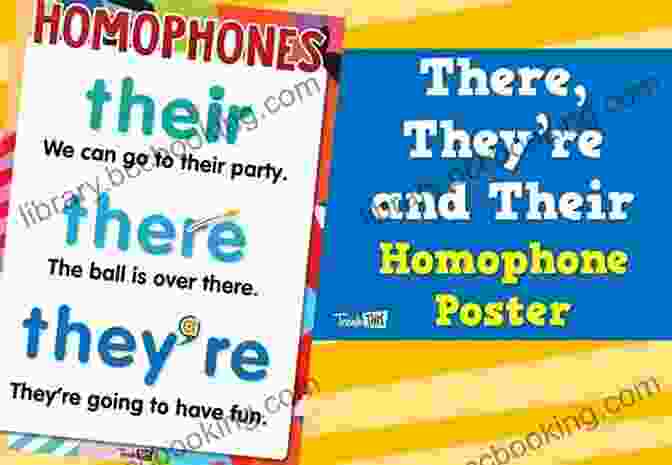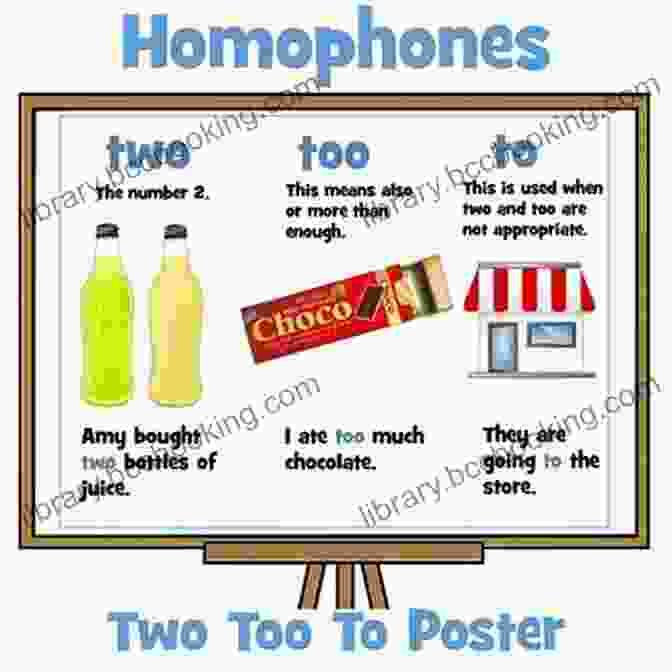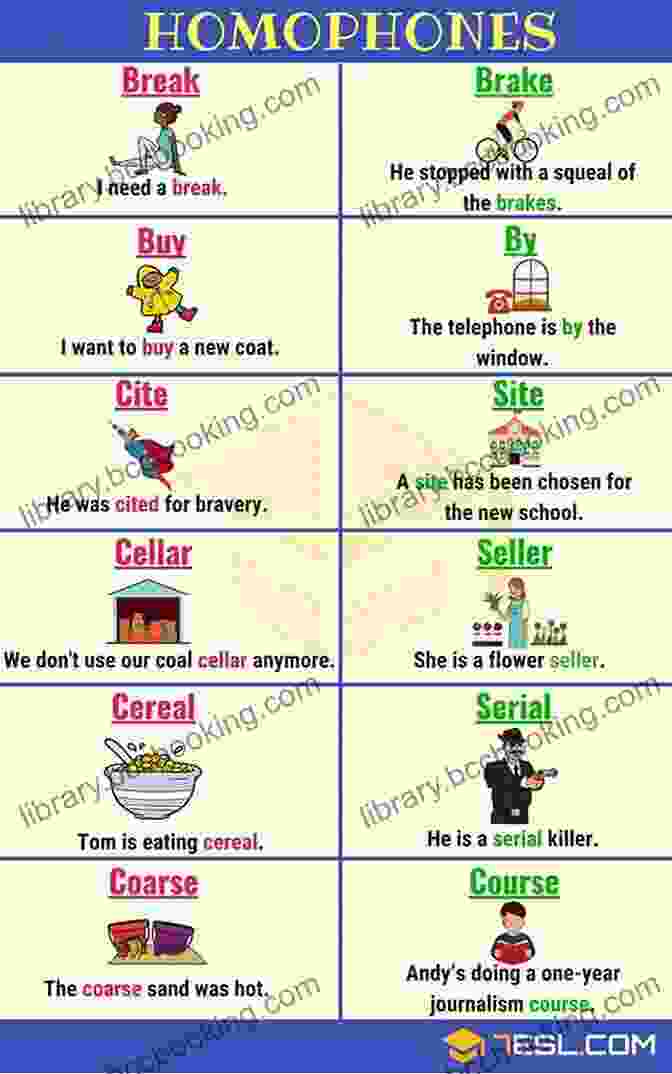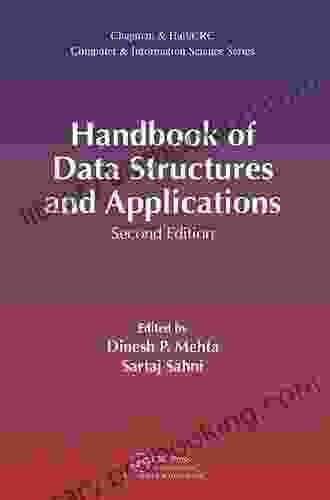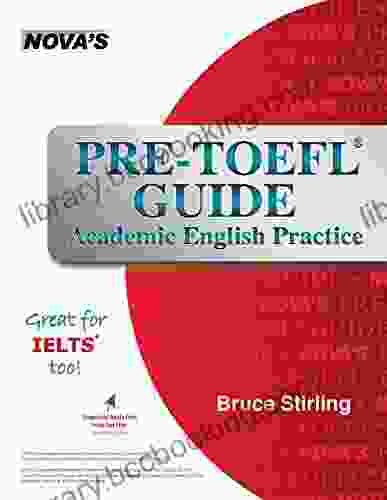Understanding Common Homophones and Homonyms in English: A Comprehensive Guide

Welcome to the enchanting realm of words, where homophones and homonyms play hide-and-seek with our understanding. These linguistic tricksters can confound even the most seasoned wordsmiths, but fear not! With this comprehensive guide, you will embark on a journey to demystify these perplexing words and emerge as a master of their subtle nuances.
What are Homophones and Homonyms?
Homophones are words that sound the same, but have different meanings and spellings, such as "there," "their," and "they're." They can be quite troublesome, leaving us scratching our heads as we try to decipher their intended usage.
5 out of 5
| Language | : | English |
| File size | : | 461 KB |
| Text-to-Speech | : | Enabled |
| Screen Reader | : | Supported |
| Enhanced typesetting | : | Enabled |
| Print length | : | 55 pages |
| Lending | : | Enabled |
Homonyms, on the other hand, are words that have the same spelling and pronunciation, but can have different meanings depending on the context. For instance, "bank" can refer to a financial institution or the sloping edge of a river.
Navigating the Labyrinth of Homophones
Mastering homophones requires careful attention to context and spelling. Here's how you can conquer these linguistic traps:
- Context is King: The surrounding words and phrases provide invaluable clues to the intended meaning of a homophone. For example, "there" is used to indicate a place, while "their" is used to indicate possession, and "they're" is a contraction of "they are."
- Know Your Spellings: Familiarize yourself with the correct spellings of homophones. This will prevent you from committing common errors like confusing "to" and "too" or "write" and "right."
- Practice Makes Perfect: Engage in regular reading and writing exercises to reinforce the usage of homophones. Pay close attention to how they are employed in various contexts.
Unveiling the Secrets of Homonyms
Homonyms can be more challenging to navigate than homophones, but with careful analysis, you can unlock their meanings:
- Contextual Clues: As with homophones, context is paramount. The surrounding words and phrases will often indicate which meaning of a homonym is intended.
- Part of Speech: Consider the part of speech of a homonym. For example, "bat" can be a noun (a mammal) or a verb (to hit something).
- Historical Origins: Understanding the etymology of homonyms can provide insights into their diverse meanings. For instance, "pupil" can refer to a student or the dark opening in the center of the eye, both rooted in the Latin word for "small child."
Examples of Common Homophones and Homonyms
To further illustrate the complexities of homophones and homonyms, let's explore some common examples:
Homophones
Homonyms
Understanding homophones and homonyms is a journey that requires patience, attention to detail, and a willingness to embrace the complexities of language. By mastering these linguistic tricksters, you will expand your vocabulary, enhance your writing skills, and communicate with greater clarity and precision. Remember, with a keen eye and a curious mind, you can conquer the challenges posed by these linguistic doppelgangers and become a true master of the English language.
5 out of 5
| Language | : | English |
| File size | : | 461 KB |
| Text-to-Speech | : | Enabled |
| Screen Reader | : | Supported |
| Enhanced typesetting | : | Enabled |
| Print length | : | 55 pages |
| Lending | : | Enabled |
Do you want to contribute by writing guest posts on this blog?
Please contact us and send us a resume of previous articles that you have written.
 Book
Book Novel
Novel Page
Page Chapter
Chapter Text
Text Story
Story Genre
Genre Reader
Reader Library
Library Paperback
Paperback E-book
E-book Magazine
Magazine Newspaper
Newspaper Paragraph
Paragraph Sentence
Sentence Bookmark
Bookmark Shelf
Shelf Glossary
Glossary Bibliography
Bibliography Foreword
Foreword Preface
Preface Synopsis
Synopsis Annotation
Annotation Footnote
Footnote Manuscript
Manuscript Scroll
Scroll Codex
Codex Tome
Tome Bestseller
Bestseller Classics
Classics Library card
Library card Narrative
Narrative Biography
Biography Autobiography
Autobiography Memoir
Memoir Reference
Reference Encyclopedia
Encyclopedia Mary Douglas
Mary Douglas Liisa Vexler
Liisa Vexler Mohammed Akberali
Mohammed Akberali Spike Carlsen
Spike Carlsen Philip Reeve
Philip Reeve Wendy Higgins
Wendy Higgins Mahesh Daas
Mahesh Daas Michel Pratt
Michel Pratt Will Durant
Will Durant Nelson Mandela
Nelson Mandela Sally Connolly
Sally Connolly Linda Vater
Linda Vater Paul O Meara
Paul O Meara Richard M Burton
Richard M Burton Liliana Maria Isella
Liliana Maria Isella Lisa Sabin Wilson
Lisa Sabin Wilson Sonia Pressman Fuentes
Sonia Pressman Fuentes Will Dean
Will Dean Quentin Blake
Quentin Blake J M Hofer
J M Hofer
Light bulbAdvertise smarter! Our strategic ad space ensures maximum exposure. Reserve your spot today!

 Charlie ScottUnveiling "The First Half Collection": A Literary Gem that Illuminates the...
Charlie ScottUnveiling "The First Half Collection": A Literary Gem that Illuminates the... Kazuo IshiguroFollow ·12.3k
Kazuo IshiguroFollow ·12.3k Chad PriceFollow ·8.6k
Chad PriceFollow ·8.6k Esteban CoxFollow ·15.2k
Esteban CoxFollow ·15.2k Ethan MitchellFollow ·8.1k
Ethan MitchellFollow ·8.1k Abe MitchellFollow ·17.5k
Abe MitchellFollow ·17.5k Dave SimmonsFollow ·4.1k
Dave SimmonsFollow ·4.1k Norman ButlerFollow ·17.9k
Norman ButlerFollow ·17.9k Christian BarnesFollow ·13.5k
Christian BarnesFollow ·13.5k

 Brian Bell
Brian BellExploring The Natural World Through Mindful Expressive...
Unleash the...

 David Baldacci
David BaldacciJourney into the Enigmatic World of "Grass" by Sheri S....
Prepare to be captivated by "Grass," a...

 Dashawn Hayes
Dashawn HayesBusting Myths About Human Nature: Unraveling the Complex...
Challenging the...

 Ernest Hemingway
Ernest HemingwayNotes on Suicide: A Profound Exploration of the...
Suicide, a taboo subject shrouded in...
5 out of 5
| Language | : | English |
| File size | : | 461 KB |
| Text-to-Speech | : | Enabled |
| Screen Reader | : | Supported |
| Enhanced typesetting | : | Enabled |
| Print length | : | 55 pages |
| Lending | : | Enabled |



